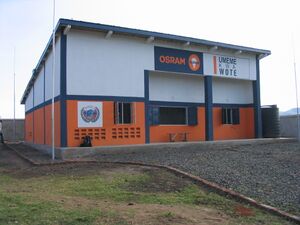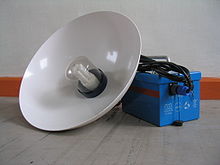Knowledge fuels change
For over a decade, Energypedia has shared free, reliable energy expertise with the world.
We’re now facing a serious funding gap.
Help keep this platform alive — your donation, big or small, truly matters!
Thank you for your support
Off-grid project in Kenya by OSRAM
Energy Hubs and Off-Grid lighting devices by OSRAM
The OSRAM energy hubs, Off-grid technologies, operational model and lighting devices represents alternative energy services for lighting, mobile phone charging and drinking water treatment for the rural fishing communities in Suba District – Kenya. Main emphasis of the project is to replace kerosene based lighting in households and fishing sector with efficient CFLs powered by batteries charged with solar energy. The design, infrastructure, technical equipment and operational model of the O-Hubs (OSRAM Energy Hubs) in Suba District are based on the model installation in Mbita, the main town in the District. The reproduction of a standard installation allows taking advantage of economy of scale effects.
According to the standard an O–Hub is equipped with:
• A battery charging station for the O-box and battery powered lantern
• A NOKIA mobile phone charging station
• A water purification and sterilization plant with rainwater harvesting and collection System
• A sales room, storage, and office.
O-Hubs are further leasing, sale and service points for OSRAM products based on renewable energy technologies, as well as a recycling and collection point for end-of-life products.
3 O-Hubs are operating in Suba District: Mbita Town, Sindo Town and Nyandiwa.
O-Hub energy supply system
The main source of energy is renewable solar energy. As a backup system, depending on the availability, a connection to the local power supply systems or a generator is added. The electrical energy for an O–Hub is provided by Solar panels. (e.g. 42 Solarworld SW 220 panels with a performance of 220 Wp each). The PV - system is used to charge battery boxes, battery powered lanterns and mobile phones as well as to purify and sterilize water.
OSRAM Off-Grid lighting devices
The main technical component of an O–Hub is the battery charging station for O–Boxes (OSRAM battery boxes) and Solar Lanterns. 14 charge controllers, each of them connected to a string of three parallel connected PV-panels, can charge 112 batteries simultaneously.
O-BOX
The OSRAM battery box contains a 12 Ah/12 V sealed maintenance-free lead acid gel accumulator. The battery is protected from deep discharging through an electronic control unit. By preventing deep discharge cycles the life span of the battery can be prolonged remarkable. The unit incorporates also the handshake technology that ensures the communication between charge controller and battery. This assures that batteries are charged only at the O-Hub under professional supervision. A control LED indicates the state of charge and warns the user when the battery reaches a low charging level. A discharged battery needs to be charged for 3 hours before it can be leased again. The O-Box system offers several possibilities and are
as of use which goes beyond lighting. The standard usage solution for the O-Box is in combination with the O–Lamp (OSRAM Lamp). The O–Lamp is a lightweight lampshade with a watertight case for the OSRAM DULUX® EL SOLAR 12 V DC VARIO CFL bulb. The bulb is dimmable and has two output levels, 6 W or 11 W, which corresponds to a lighting intensity of 30 W or 60 W of traditional incandescent bulb. The O–Box with the O-Lamp provides energy for lighting for 10 up to 18 hours depending on the setup. In this configuration the O–Box is operated for Omena night fishing, household lighting as well as lighting in small business like kiosks, restaurant, shops and schools and public offices. The O–Box is further equipped with a second plug which offers the possibility to connect a second O-Lamp or other small devices like a mobile phone charger, Laptop, Radio or TV.
OSRAM Solar Lantern
The OSRAM solar charged Lantern is designed mainly for the use in households and small shops. Its equipment with a 6Ah/12V DC, maintenance-free lead acid gel accumulator to power the 7 W CFL and offers to the user up to 8 hours of lighting. After an operation cycle the Lantern, like the O–Box, is brought back to O–Hub where it can be exchanged immediately with a charged one. This continuous utilization concept is possible due to the leasing and operation system in use.
O-Hub Leasing and operation system
==
The operation concept worked out for the O–Hubs is designed to solve the main problems in access and provision of energy, especially electricity through PV–systems, in rural areas of developing countries. These are mainly high investment costs as well as high operation costs with contemporary low household incomes, but also quality deficiencies which cause unreliable energy supply. Overcoming these constraints is possible through a centralized high-quality PV–system which charge batteries under control of trained technicians. The charged batteries are further leased to fishermen, households, shop owners and schools. Subsequently they are used for lighting or fishing. Both O-Hub lighting devices are distributed via this leasing system. Through the leasing system the customer saves the high buy in and maintenance cost for a PV–system. The leasing system stipulates that customers will be registered and provide a security deposit for the duration of the usage of the O–Box or Solar Lantern. The security deposit will be refunded afterwards. The leasing agreement covers a non limited use of the lighting devices including the maintenance. The security deposit for an O–Box with lamp shade and CFL bulb amounts to 1,000 Kenya Shilling (KES)[1]. The security deposit for the Lantern amounts to 750 KES. The security deposit can also be financed in cooperation with local micro finance institutions. They provide the security deposit for the customer who in turn will repay the loan step by step. Even here the security deposit will be refunded completely to the customer once he/she decides to withdraw from the use of the O–Box or Lantern and returns it to the O–Hub. Through the leasing system the customer has the advantage to pay only for the service a household, a business or a fisherman really needs: this is lighting in the evening for cooking, eating, working, reading, extended business hours or just socialization and illumination for Omena fishing. Service fees are 75 KES for the O–Box and 25 KES for the Lantern each time a utilized lighting device is replaced with a charged one. For the customer this constitutes the total cost for lighting. Additional costs for maintenance and replacement materials are covered by the O-Hub operator. A supplementary advantage of the operation system, for both customer and the O–Hub operator, is that the property for the O–Boxes and Lanterns remains within the O–Hub. This means that whenever a discharged lighting system is returned to the O–Hub it can immediately be replaced with a charged one because there is no exclusively claim on it from the user. The customer always gets a fully charged and maintained product for the paid service fees. The O–Hub operator has the guarantee that all the products will brought back for charging, maintenance and recycling at the end of life span. The limitation of charging the batteries only at the O–Hub allows technically controlling of the process, constantly monitoring the batteries conditions and covering investments and running costs.
Mobile phone charging
Communication via mobile phones has gained massive growth rates in Kenya and other African countries. The wireless communication is a reliable way to connect remote rural areas to the centers. Although electricity is needed to utilize mobile phones, remote rural areas are poorly endowed with access to the grid. The rural population covers this lack with mobile phone charging centers, where batteries are charged with small diesel generators. The use of imported fuels and the lack of alternatives makes this service expensive and therefore communication for an already economically poorer rural population prohibitive. In an O-Hub 48 mobile telephones can be charged simultaneously with clean Solar energy from the PV-System. The costs for mobile phone charging could be reduced to 15 KES from an average of 20 KES in fossil fuel powered charging centers.
Water Purification and Sterilization
Each O–Hub is equipped with a solar powered water purification and sterilization plant. It filters the harvested rainwater mechanically and sterilizes it further with UVC-light. The water plant has a capacity of 5 liter/minute. From a storage tank the purified water is pumped into the saleroom and further distributed to the customers. They collect the water with their own containers and at quantities they require to cover their need for drinking water.
Benefits
For household lighting users OSRAM Energy Hub services bring a substantially rise in lighting quality through better illumination and lower expenditures per illuminance unit. Additionally, harmful exhaust fumes, poisoning fuels and open fire danger are removed from households.
The Omena fishing sector depends on light for the successfully harvesting of the small cyprinids. Light attracts their fodder which in turn further attracts the fish. Up to now, fishermen’s need for a bright enough and transportable light was only possible to be achieved with kerosene pressure lamps. The total costs for the 5 pressure lamps used are 758 KES/night. The O–Box offers the same service: a portable lighting device with a high illuminance. The costs for lighting with 5 O–Boxes are 375 KES for a fishing night and could therefore be reduced to a half. The use of the alternative, less polluting and energy consuming, lighting device raises the income and further the living standards for fishermen households.
Besides the economical, ecological, social and health benefits for the users the O–Hub concept also promotes, the transfer of technology through the training of the local staff. This is realized during the construction and installation phase as well as in the operative phase. Construction materials and manpower are selected locally which supports the economy in the rural areas. Subsequently, the battery boxes are also assembled in Kenya. Only materials which are not produced or not available in Kenya are imported. The complete operative part of an O-Hub is organized by a local OSRAM partner who is supported by his local staff. The technical, as well as, the administrative staff are trained in the maintenance and operation of the solar energy powered energy stations.
Cumulatively the O–Hub operational model allows minimizing the costs for the customers and maximizing the benefits for the local community, economy, environment and O–Hub Operator.
- ↑ 1 Kenya Shilling = 0.0124 US$ (August 2010)






















